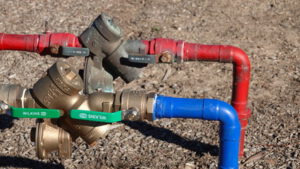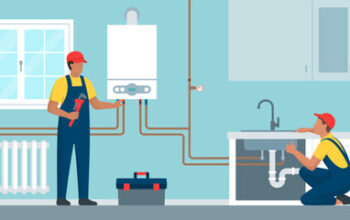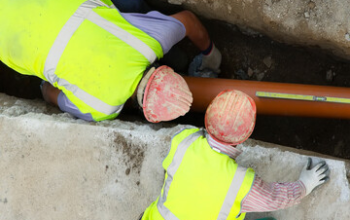Backflow maintenance helps keep your building’s occupants and the city’s water system safe from contamination. This includes having your backflow preventer inspected annually by a backflow-certified technician.

Make sure you have all the needed tools available before starting maintenance on your backflow prevention assembly. It is also important to have a proper work area for maintenance. Visit https://myjoeplumber.com/plumber-the-woodlands-tx/ to learn more.
The check valve is a one-way valve that allows flow to move in only one direction. If the flow turns backward, it closes to prevent backflow, which could damage piping, pumps, and other equipment in a system.
Most check valves are spring-loaded with a disc that is balanced on a pivot point. Upstream pressure pushes the disc up off its seat to allow flow to pass through. If the upstream pressure is reduced, gravity or higher downstream pressure forces the disc to lower onto its seat and shut off reverse flow.
A lift-check is another type of check valve in which the disc, also known as a lift, can be lifted vertically off its seat by higher upstream fluid pressure. A guide keeps the motion of the disc on a straight line, and it is kept from moving too far by gravity and higher downstream pressure. If upstream pressure decreases below the cracking pressure or there is backflow, the disc will be forced to reseat on its seat and shut off reverse flow.
Incorrect sizing is one of the main causes of premature check valve failure. The valve needs to be sized correctly for the application and service conditions in order to have the longest possible trouble-free life. If the valve is too large for the application, there will not be enough pressure drop to fully open it. This can cause chattering of the disc and lead to premature failure.
A common issue that leads to early check valve failure is debris lodged between the #2 check seat and sealing disc. When this happens, the seat and disc are not in contact with each other, causing the components to wear down. Another problem that can lead to the failure of a check valve is water hammer, in which a reversal of flow causes the valve to suddenly close, creating an extreme pressure wave that will damage piping and other equipment.
A dual check with atmospheric port (DCAP) is a backflow preventer that combines two independent check valves with an intermediate atmospheric vent. This prevents both back pressure and back siphonage. They are used in residential supply lines, fire sprinkler systems, non-health-hazard cross-connections, and sterilizers.
Relief Valve
The relief valve is an important part of any backflow preventer. It is designed to operate in conjunction with the double check valve backflow prevention assembly and allow water flow to pass downstream while maintaining a pressure drop equal to or less than the supply line pressure. The valve is equipped with test cocks and a removable cap for easy maintenance and testing. Many codes and standards have been developed worldwide for the design, installation, and operation of this type of relief valve. These codes are used by government agencies, manufacturers, and users and may be written into construction or purchasing specifications.
When the water pressure in the end user’s system drops, the backflow preventer’s #1 and #2 check valves close. The tension of the #1 check spring maintains a pressure difference between the supply line and the zone of reduced pressure (typically 2.0 PSID). If this differential is greater than the supply line pressure minus the relief valve spring loading, the valve opens.
In a balanced pilot-operated relief valve, there is an inlet, an outlet, and two poppets: the main poppet and a bolted-on pilot poppet that determine the pressure setting. The main poppet is supported by a soft, non-adjustable spring, and the pilot poppet is supported by a much stiffer, adjustable spring. The main and pilot poppets have approximately the same surface area, so the pressure on each side is the same. When the system’s pressure rises to the point of cracking the pilot poppet, the main poppet will rise. This allows media above the main poppet to flow to the outlet and relieves the pressure on the system, keeping it from exceeding the process component’s MAWP.
The discharge from the relief valve is normally into a venting system that is piped to the outside of the building. This is done to keep hazardous gases from escaping into the atmosphere. It is important to have these systems sized correctly. Often, a gas blowby condition will occur when the relief valve is improperly sized and not able to handle the design maximum allowable flow rate into the process component.
Body
When water is pushed through plumbing systems, it should only flow in one direction. But sometimes, a sudden change in pressure can cause backflow. This can contaminate the city’s drinking water supply with chemicals, human waste, or other pollutants. That’s why New York State requires certain properties to install, test, and maintain backflow preventers.
Backflow prevention assemblies are mechanical devices with internal seals, springs, and moving parts. Over time, these components can be subject to clogging, wear, and fatigue. If they become faulty, it’s a good idea to get them repaired or replaced. But deciding whether to repair or replace your backflow device can be difficult, and it depends on several factors.
First, you’ll want to consider how old your backflow preventer is. The average life of a backflow preventer is 12 years. However, some can last longer than that. You’ll also want to think about the location of your backflow preventer. Backflow preventers are typically located in outdoor, above-ground enclosures. These units can be difficult to work on if they’re in a cramped space or on the ground, so having them in an accessible place will make it easier to perform maintenance.
Another important factor to consider is the cost of repairs and replacements. Unless you have an extended warranty or other financial protections, the cost of fixing or replacing your backflow preventer can be expensive. But you’ll need to weigh these costs against the cost of potential contamination and the risk of losing your backflow preventer altogether.
As a certified backflow tester, Kiddco can help you determine the best course of action for your backflow preventer. On testing day, our technicians will shut off your water service temporarily so they can open and close your backflow valves and take pressure measurements. Once the backflow test is complete, your plumber will restart your water service, fill out the necessary paperwork, and submit your results directly to the city’s Division of Water. If you’re concerned about your backflow prevention system, contact us to schedule a service today. We’re a family-owned and operated company with over 20 years of experience in NYC.
Software
Backflow preventers are installed in water systems to ensure that unsafe water doesn’t flow backward into the drinking water supply. It’s critical to make sure that these devices are properly maintained. Backflow preventers need to be tested on an annual basis to make sure that they’re working correctly. In addition, they need to be inspected for any signs of problems, such as leaking valves or strange noises.
One way to do this is by using backflow prevention software. This software allows you to keep digital records on all your backup devices. This makes it easy to monitor all the tests and inspections that have been performed. It also helps you meet state requirements for backflow monitoring.
There are many different backflow prevention software programs available. Some are free to use, but they may have limitations and not include all the features that you need for your backflow program. Other programs cost a bit more, but they offer more functionality and can help you run your backflow program more efficiently.
When choosing a backflow prevention software program, it’s important to look for a system that allows you to track all your testing and inspection data. It should also have a flexible query function that lets you sort and display information the way you want to see it. Also, it should allow you to add a new test site or backflow prevention assembly without bringing the process to a halt. It should also let you enter a tester or test kit on the fly, as well as allow you to do lookups by name and certification number.
Performing repairs on backflow prevention assemblies requires special tools. Depending on the model of backflow device, these may be standard hand tools or specialized tools. A backflow prevention technician must determine if these tools are necessary for each specific job before attempting to repair the device.
Another way to manage your backflow prevention program is to hire a service company. This option is popular with large city-run water utilities and can be effective if your organization doesn’t have the resources to run its own backflow prevention program.



